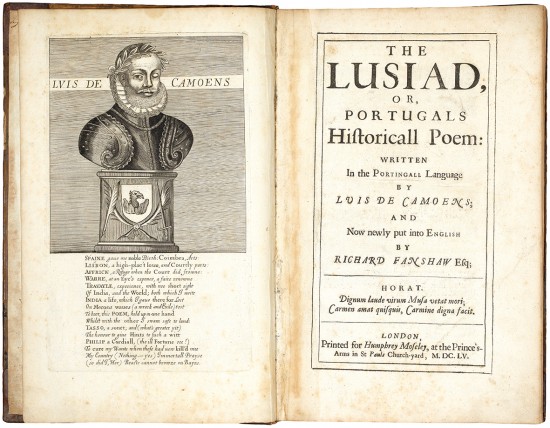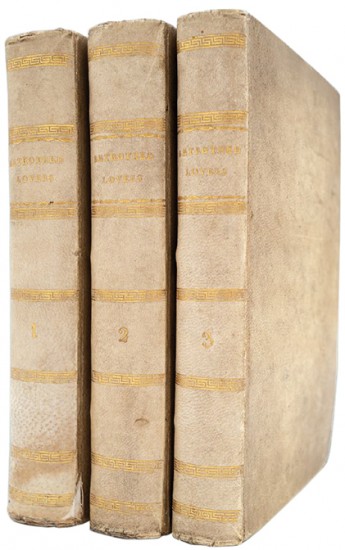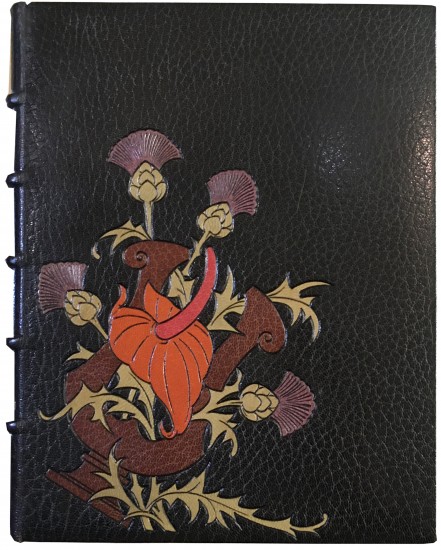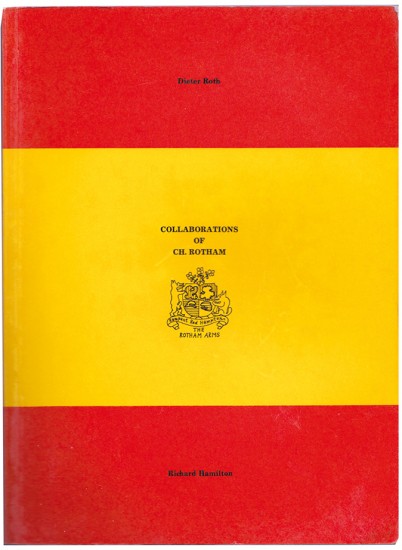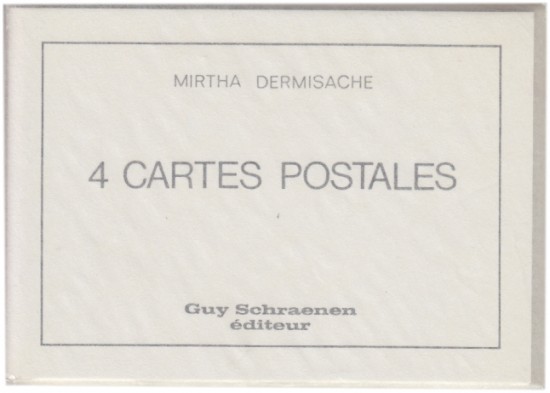The Lusiad, or, Purtugals Historicall Poem: Written in the Portingall Language by Luis de Camoens; and Now Newly Put into English by Richard Fanshaw
Camoens, Luis de. (Luís Vaz de Camões)
London. Printed for Humphrey Moseley, at the Prince's-Arms in St Pauls Church-Yard. 1655
Sold
A very scarce large paper presentation copy of the first edition in English of Portugal's greatest literary masterpiece, Luis de Camões' epic 'Os Lusíadas'.
The epic poet of Portuguese literature and the architect of the literary monument to Portuguese exploration, Luís de Camões (c.1524 - 1580) has often been acclaimed as to Portugal what Cervantes is to Spain, or Shakespeare is to England, the literary embodiment of the national spirit. Written over a number of years, de Camões 'Os Lusíadas'- literally 'the sons of Lusus' after the mythical founder of Portugal - was first published in Portuguese in 1572 and takes as its model Virgil's Aeneid, albeit with Vasco da Gama replacing Aeneas as its hero. Composed in ten cantos in the modern ottava rima of Ariosto there is debate as to when and exactly where de Camões wrote his epic (both Goa and Lisbon have been suggested), but there is no doubt that he made use of his extensive travels and the ensuing experiences to give verisimilitude to his magnum opus.
After an early education by monks, de Camões entered the University of Caimbra and travelled to Lisbon in 1544 where his verse and dramatic work attracted the attention of the Court. Soon, however, de Camões proved controversial with his drama based on the life of the Syrian King Seleucus and his son Antiochus (the work was considered a critique of the ruling king's father and other ancestors) and de Camões was exiled. He lost an eye at the siege of Ceuta in North Africa and returned to Lisbon in 1550 to further controversy: in 1552 when he injured a court official in a brawl de Camões was imprisoned and was released nine months later on the condition that he served the crown in India. de Camões arrived in Goa in March 1553, was sent to Macao in 1556 (occasioned again by political and literary misdemeanours) but it is not clear that he ever arrived. He was shipwrecked at the mouth of the Mekong River and journeying via Malacca returned to Goa in 1561. In 1567 de Camões travelled to Mozambique on his return journey, arriving in Lisbon on April 7th, 1570; the first edition of 'Os Lusíadas' was published two years later, in 1572.
One of the greatest poems of the Renaissance, 'Os Lusíadas' takes as its central theme, the journey of discovery made by Vasco da Gama via southern Africa to India in 1497 - 1498 at the instigation of Henry the Navigator, and it is da Gama as well as Portugal that are the heroes of the work. Intensely literary in a classical sense, 'Os Lusíadas' is filled with allusion as is its model, the Aeneid, a work that de Camões aimed to surpass. Notwithstanding the work's profound literary merits, it is also highly important in terms of the geographical (de Camões is accurate consistently), the botanical (dozens of exotic plants are described), the ethnographic and the historical as well as in its depiction of fauna and the quotidian detail of travel and exploration.
As mentioned previously, the first edition together with a concurrent pirated edition were issued in 1572. A Spanish edition in Castilian was published in 1580 followed by editions in Latin, French and Italian, but no English edition was published until the present version, translated by the noted linguist and diplomat Sir Richard Fanshawe (modern usage adds the terminal 'e') and issued in 1655. Fanshawe (1608 - 1666) showed early linguistic skill and perfected his Spanish in Madrid in 1632 before his return to England and appointment as secretary to Walter, Lord Aston, the ambassador; he served also under Aston's successor, Sir Arthur Hopton. During the Interregnum, Fanshawe attended the exiled Charles and was captured at the Battle of Worcester before his release on grounds of ill health. Internal exile at Tankersley Park - seat of the Earl of Strafford, the dedicatee of the book - saw Fanshawe engaged in a prolonged period of translation and it was there that he produced this version of 'Os Lusíadas' as well as a portion in Latin in hexameters, a Latin translation of Fletcher's 'The Faithful Shepherdess' and translations from Spanish literature. At the Restoration Fanshawe was elected M. P. for Cambridge and was sent by Charles II in 1662 to Lisbon as ambassador before his appointment as ambassador to Spain in 1664.
This large paper presentation copy is of the utmost scarcity and Fanshawe's presentation, to his brother-in-law a couple of months after publication (the printed dedication is dated 'May 1'), in English with a quotation in Spanish apparently from Lope de Vega, is in sepia ink to a leaf tipped-in at the foot of the printed dedication: 'Aug: 22. 1655. / FFor my honord ffreind Sr. George Boteler / from his most affectionate servant & / Countryman / Richard FFanshawe / La patria e solamente buena, para nacer, y morir, / en ella.'
Thereafter the book passed through several very distinguished collections including that of Michael Wodhull, the translator of Euripides into English, who purchased this copy on February 11th, 1782, adding his arms to the front board together with various bibliographical details. A later owner, James Bindley, added further bibliographical detail, but perhaps those of most interest, apart from Sir Richard Fanshawe's manuscript corrections to the text, are further corrections added by a descendant, Basil Thomas Fanshawe, who transcribed them from another presentation copy, that given by Sir Richard to his nephew Thomas Leventhorpe. Presentation copies are truly scarce and apart from the present and the aforementioned, only the Pforzheimer copy (inscribed to Edward Heath) and the Houghton copy (inscribed to another nephew, Francis Compton) can be traced.
' ... Os Lusíadas ... is that country's [Portugal's] canonical work par excellence, the one to which poets and historians constantly refer ... Great poetry in praise of great deeds, Os Lusíadas, conceived in part as a glorification of Portugal's imperial destiny, lives on as a monument to the everlasting empire of words.' (Michael Freeman).
'The Lusiads and its poet won the praise of Miguel de Cervantes, Luis de Gongora, and Torquato Tasso. Lope de Vega professedly placed it above the Aeneid and the Iliad in his estimation ... The Lusiads is a synthesis of all the elements included in the reality and myth of Portugal's overseas expansion. It captures the heroism and the suffering, the glory and the disillusionment, the generosity and the avarice which characterized the national enterprise. The author himself was the only major Portuguese poet to participate personally in the voyage, the wars, and the rigors of life in Asia. His epic successfully combines the personal with the national experience and provides thereby an intelligible, individualistic expression of the collective enterprise in which Portuguese of all walks of life had engaged either directly or indirectly ... It teaches a love for human diversity and in Canto X shows how man and the earth are fused together within a larger universe.' (Lach).
[Pforzheimer 362; Wing C397; see Donald F. Lach's 'Asia in the Making of Europe', vol. II, pp. 149 - 160].
The epic poet of Portuguese literature and the architect of the literary monument to Portuguese exploration, Luís de Camões (c.1524 - 1580) has often been acclaimed as to Portugal what Cervantes is to Spain, or Shakespeare is to England, the literary embodiment of the national spirit. Written over a number of years, de Camões 'Os Lusíadas'- literally 'the sons of Lusus' after the mythical founder of Portugal - was first published in Portuguese in 1572 and takes as its model Virgil's Aeneid, albeit with Vasco da Gama replacing Aeneas as its hero. Composed in ten cantos in the modern ottava rima of Ariosto there is debate as to when and exactly where de Camões wrote his epic (both Goa and Lisbon have been suggested), but there is no doubt that he made use of his extensive travels and the ensuing experiences to give verisimilitude to his magnum opus.
After an early education by monks, de Camões entered the University of Caimbra and travelled to Lisbon in 1544 where his verse and dramatic work attracted the attention of the Court. Soon, however, de Camões proved controversial with his drama based on the life of the Syrian King Seleucus and his son Antiochus (the work was considered a critique of the ruling king's father and other ancestors) and de Camões was exiled. He lost an eye at the siege of Ceuta in North Africa and returned to Lisbon in 1550 to further controversy: in 1552 when he injured a court official in a brawl de Camões was imprisoned and was released nine months later on the condition that he served the crown in India. de Camões arrived in Goa in March 1553, was sent to Macao in 1556 (occasioned again by political and literary misdemeanours) but it is not clear that he ever arrived. He was shipwrecked at the mouth of the Mekong River and journeying via Malacca returned to Goa in 1561. In 1567 de Camões travelled to Mozambique on his return journey, arriving in Lisbon on April 7th, 1570; the first edition of 'Os Lusíadas' was published two years later, in 1572.
One of the greatest poems of the Renaissance, 'Os Lusíadas' takes as its central theme, the journey of discovery made by Vasco da Gama via southern Africa to India in 1497 - 1498 at the instigation of Henry the Navigator, and it is da Gama as well as Portugal that are the heroes of the work. Intensely literary in a classical sense, 'Os Lusíadas' is filled with allusion as is its model, the Aeneid, a work that de Camões aimed to surpass. Notwithstanding the work's profound literary merits, it is also highly important in terms of the geographical (de Camões is accurate consistently), the botanical (dozens of exotic plants are described), the ethnographic and the historical as well as in its depiction of fauna and the quotidian detail of travel and exploration.
As mentioned previously, the first edition together with a concurrent pirated edition were issued in 1572. A Spanish edition in Castilian was published in 1580 followed by editions in Latin, French and Italian, but no English edition was published until the present version, translated by the noted linguist and diplomat Sir Richard Fanshawe (modern usage adds the terminal 'e') and issued in 1655. Fanshawe (1608 - 1666) showed early linguistic skill and perfected his Spanish in Madrid in 1632 before his return to England and appointment as secretary to Walter, Lord Aston, the ambassador; he served also under Aston's successor, Sir Arthur Hopton. During the Interregnum, Fanshawe attended the exiled Charles and was captured at the Battle of Worcester before his release on grounds of ill health. Internal exile at Tankersley Park - seat of the Earl of Strafford, the dedicatee of the book - saw Fanshawe engaged in a prolonged period of translation and it was there that he produced this version of 'Os Lusíadas' as well as a portion in Latin in hexameters, a Latin translation of Fletcher's 'The Faithful Shepherdess' and translations from Spanish literature. At the Restoration Fanshawe was elected M. P. for Cambridge and was sent by Charles II in 1662 to Lisbon as ambassador before his appointment as ambassador to Spain in 1664.
This large paper presentation copy is of the utmost scarcity and Fanshawe's presentation, to his brother-in-law a couple of months after publication (the printed dedication is dated 'May 1'), in English with a quotation in Spanish apparently from Lope de Vega, is in sepia ink to a leaf tipped-in at the foot of the printed dedication: 'Aug: 22. 1655. / FFor my honord ffreind Sr. George Boteler / from his most affectionate servant & / Countryman / Richard FFanshawe / La patria e solamente buena, para nacer, y morir, / en ella.'
Thereafter the book passed through several very distinguished collections including that of Michael Wodhull, the translator of Euripides into English, who purchased this copy on February 11th, 1782, adding his arms to the front board together with various bibliographical details. A later owner, James Bindley, added further bibliographical detail, but perhaps those of most interest, apart from Sir Richard Fanshawe's manuscript corrections to the text, are further corrections added by a descendant, Basil Thomas Fanshawe, who transcribed them from another presentation copy, that given by Sir Richard to his nephew Thomas Leventhorpe. Presentation copies are truly scarce and apart from the present and the aforementioned, only the Pforzheimer copy (inscribed to Edward Heath) and the Houghton copy (inscribed to another nephew, Francis Compton) can be traced.
' ... Os Lusíadas ... is that country's [Portugal's] canonical work par excellence, the one to which poets and historians constantly refer ... Great poetry in praise of great deeds, Os Lusíadas, conceived in part as a glorification of Portugal's imperial destiny, lives on as a monument to the everlasting empire of words.' (Michael Freeman).
'The Lusiads and its poet won the praise of Miguel de Cervantes, Luis de Gongora, and Torquato Tasso. Lope de Vega professedly placed it above the Aeneid and the Iliad in his estimation ... The Lusiads is a synthesis of all the elements included in the reality and myth of Portugal's overseas expansion. It captures the heroism and the suffering, the glory and the disillusionment, the generosity and the avarice which characterized the national enterprise. The author himself was the only major Portuguese poet to participate personally in the voyage, the wars, and the rigors of life in Asia. His epic successfully combines the personal with the national experience and provides thereby an intelligible, individualistic expression of the collective enterprise in which Portuguese of all walks of life had engaged either directly or indirectly ... It teaches a love for human diversity and in Canto X shows how man and the earth are fused together within a larger universe.' (Lach).
[Pforzheimer 362; Wing C397; see Donald F. Lach's 'Asia in the Making of Europe', vol. II, pp. 149 - 160].
[123 leaves + 3 inserted leaves with presentation and two engraved plates; pp. (i), (i), (xix), 224]. Small folio. (318 x 206 mm). Leaf with engraved portrait of Camões and dedicatory verse, printed title within double-ruled frame, two leaves with Fanshaw's dedication to the Earl of Strafford and tipped-in presentation from Fanshaw (see below), Petronius' Latin text and English translation on facing pages of following 7 leaves, 'The Translator's Postscript' to verso of final leaf, leaf with quotation from Tasso above English translation, two leaves with engraved portraits of 'Prince Henry of Portugall' (folded as usual at outer edge) and 'Vasco da Gama' by T. Cross (shaved at outer edge) bound en face and Cantos I - X of Fanshaw's translation, final leaf with 'FINIS' between printed rules, elaborate decorative woodcut head-piece to dedication and opening of Canto I and decorative woodcut 11-line historiated initial to dedication and 8-line initial to Canto I, four woodcut head-pieces; Fanshaw's translation printed five stanzas per page with running title in Roman type throughout with words and phrases in italic, proper nouns in capitals. Early eighteenth-century mottled calf, boards with double gilt rules and thistle tools at corners, central armorial vignette in gilt to front board, banded spine replaced and ruled in gilt with original red morocco label with gilt title 'FANSHAW'S / LUSIAD' preserved, a.e.g.
#45539
